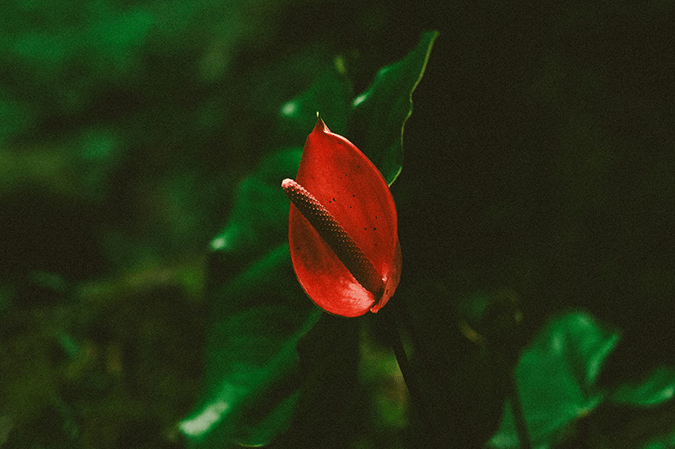Description
Laceleaf, commonly known as Anthurium, is a genus of flowering plants in the Araceae family. The genus contains around 1,000 species, making it one of the largest genera in the Araceae family. Anthurium species are native to the tropical regions of the Americas, particularly Central and South America. The most commonly cultivated species is Anthurium andraeanum, known for its distinctive glossy, heart-shaped leaves and bright, colorful spathes (often mistakenly called flowers). The spathes are usually red but can also be pink, white, or green and are accompanied by a spadix, a spike of tiny, true flowers.
Common Features
- Leaves: Laceleaf plants have large, heart-shaped, or lanceolate leaves that are usually dark green and glossy. The leaves can vary significantly in size, depending on the species, with some growing up to 18 inches long. The leaves are often leathery in texture and can have a striking appearance due to their prominent veins.
- Flowers: What is commonly referred to as the “flower” of the laceleaf is actually a spathe, which is a modified leaf that surrounds the spadix. The spadix contains the true flowers, which are small and packed closely together. The spathe is typically bright red, though it can also be found in shades of pink, white, orange, or green. The spathe’s shiny, waxy texture adds to the plant’s ornamental appeal.
- Growth Habit: Laceleaf plants are typically epiphytic or semi-epiphytic, meaning they can grow on other plants (like trees) or in the soil. They have a clumping growth habit and can reach heights of 1 to 3 feet indoors, though they can grow larger in their natural habitat.
- Roots: Anthuriums have thick, fleshy roots that help them absorb moisture and nutrients. The roots are often aerial, allowing the plant to cling to surfaces and absorb humidity from the air.
Role in the Ecosystem
- Epiphytic Relationships: In their natural tropical habitats, many Anthurium species grow as epiphytes on trees. This growth habit allows them to access light and air in dense forest environments. They do not harm their host plants but benefit from the elevated position, which provides better light and air circulation.
- Pollination: Laceleaf plants rely on insects, particularly beetles and flies, for pollination. The bright colors and unique structure of the spathes attract these pollinators. The plants produce a sweet, sometimes slightly pungent scent to lure pollinators to the spadix, where pollination occurs.
- Habitat Contribution: By growing on trees or in the understory, Anthurium plants contribute to the complexity and diversity of tropical forest ecosystems. Their presence supports a variety of insects and other small organisms, and their foliage provides cover and habitat within these ecosystems.
Importance
- Ornamental Value: Anthurium species are highly prized as ornamental plants, both indoors and outdoors, due to their striking appearance and relatively easy care. They are commonly used in tropical-themed gardens, as houseplants, and in floral arrangements. The long-lasting spathes and attractive foliage make them a favorite among gardeners and plant enthusiasts.
- Cultural Significance: In some cultures, Anthurium flowers are associated with hospitality, happiness, and abundance. They are often used in tropical floral arrangements and are popular as gifts and decorations during festive occasions.
- Air Purification: Laceleaf plants are known to help purify indoor air by absorbing volatile organic compounds (VOCs) and releasing oxygen. This makes them a popular choice for improving air quality in homes and offices.
- Economic Importance: The cultivation and sale of Anthurium plants are a significant part of the horticultural industry, particularly in tropical and subtropical regions. They are one of the most commercially important genera in the floriculture market, especially in the production of cut flowers and potted plants. Their vibrant colors and long-lasting blooms make them popular in the global flower trade.
- Medicinal Uses: While Anthurium plants are primarily ornamental, some traditional medicine practices use them for various purposes. However, it is important to note that Anthurium plants contain calcium oxalate crystals, which can be toxic if ingested, causing irritation and swelling in the mouth and throat.
Sources
- Royal Horticultural Society. (n.d.). Anthurium (Laceleaf) – Plant Finder. Retrieved from RHS
- Encyclopedia Britannica. (n.d.). Anthurium | Plant Genus Overview. Retrieved from Encyclopedia Britannica
- University of Florida, IFAS Extension. (n.d.). Anthurium – Care and Growing Tips. Retrieved from UF IFAS Extension



